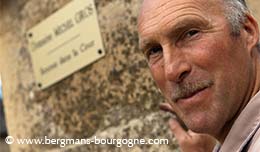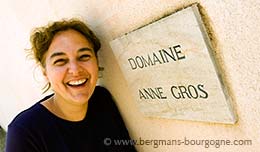
f you look at a map of the Mâconnais there are something like a hundred different types of soil. Even if you go to Cruzille, saying Cruzille makes good wine, it is a lie. The appellation means nothing to us. That’s why we don’t focus on it. We focus on the individual vineyards.
Emmanuel Guillot and his brother Patrice at Domaine Guillot-Broux in Cruzille are pursuing the adventure their father embarked upon back in 1978, restoring and replanting old vineyards that have been abandoned since the phylloxera.
 Cruzille is a small village with some 300 inhabitants in the northern part of the Mâconnais, roughly half-way between Mâcon and Chalon-sur-Saône. There are only four growers within Mâcon-Cruzille, the regional appellation for the village.
Cruzille is a small village with some 300 inhabitants in the northern part of the Mâconnais, roughly half-way between Mâcon and Chalon-sur-Saône. There are only four growers within Mâcon-Cruzille, the regional appellation for the village.
– 1978 was when Domaine Guillot-Broux was born, says Emmanuel Guillot. Guillot was my father’s name. Broux was my mother’s name. Before that there was my grandfather’s domaine here in the village. He started out in the 1950s and it was the first organic domaine in Burgundy.
– My father spent time in both Meursault (Domaine Bernard Michelot) and Brouilly (Domaine de la Chanal), and brought back a lot of knowledge. High density planting, working with single vineyards, winemaking techniques – he learnt a lot, especially in Meursault. We do both fermentations – malolactic and alcoholic – in barrel.
 The 17 hectares of Domaine Guillot-Broux are spread over Cruzille and the two neighbouring villages of Chardonnay and Grevilly. Up until 2005 the appellation Mâcon-Grevilly was available for the latter, but it has since become Mâcon-Cruzille. Chardonnay has its own appellation, Mâcon-Chardonnay. But as Emmanuel Guillot points out, at Domaine Guillot-Broux the appellations are of less importance. Only the three négociant wines carry the appellation names up front. All the others, the single vineyard wines, with the exception of the Les Geniévrières, which still carries the old label, have the vineyard name as the focusing point on the label.
The 17 hectares of Domaine Guillot-Broux are spread over Cruzille and the two neighbouring villages of Chardonnay and Grevilly. Up until 2005 the appellation Mâcon-Grevilly was available for the latter, but it has since become Mâcon-Cruzille. Chardonnay has its own appellation, Mâcon-Chardonnay. But as Emmanuel Guillot points out, at Domaine Guillot-Broux the appellations are of less importance. Only the three négociant wines carry the appellation names up front. All the others, the single vineyard wines, with the exception of the Les Geniévrières, which still carries the old label, have the vineyard name as the focusing point on the label.
– The story of the domaine is very closely linked with replanting old vineyards, says Emmanuel Guillot. There is still much land available around here. It’s slowly growing, but it’s really only we and my cousin (Julien Guillot, Domaine des Vignes du Maynes) who are doing this restoration of old vineyards.
 It is a task which requires a lot of time and money. The forest has to be cleared, the soil restored and vines planted. We are talking about ten years of investments here before you have any bottles to sell.
It is a task which requires a lot of time and money. The forest has to be cleared, the soil restored and vines planted. We are talking about ten years of investments here before you have any bottles to sell.
– My father bought Les Geniévrières for 800 francs per hectare (roughly €200 in today’s money). I mean, the cost of the tax was more important than the cost of the land. We are still able to buy land around here at relatively modest prices. It’s around €4000 per hectare.
 – We started replanting Les Geniévrières in 1983. My father knew, thanks to a guy in the village, that it is a very good terroir. Having spent ten years in Meursault he thought that a plot called Les Geniévrières wasn't such a bad idea. So he bought everything. We have eight hectares now. We planted chardonnay, pinot noir and gamay. After 20 years we know that it’s mainly for chardonnay and pinot noir. The gamay doesn’t work there.
– We started replanting Les Geniévrières in 1983. My father knew, thanks to a guy in the village, that it is a very good terroir. Having spent ten years in Meursault he thought that a plot called Les Geniévrières wasn't such a bad idea. So he bought everything. We have eight hectares now. We planted chardonnay, pinot noir and gamay. After 20 years we know that it’s mainly for chardonnay and pinot noir. The gamay doesn’t work there.
Emmanuel Guillot returned to Cruzille in 1999, after having spent two and a half years in London working as a sommelier, followed by a stint in Paris.
– I returned here because first of all it’s a way of life. My wife is English and we had the choice between 50 square metres in the second or third zone in London and a 200 square metre house here surrounded by fields.
 There are nine single vineyard wines at Domaine Guillot-Broux. Six whites and three reds. All whites are chardonnay, while two of the reds are pinot noir (Les Geniévrières and La Myotte) and one gamay (Beaumont).
There are nine single vineyard wines at Domaine Guillot-Broux. Six whites and three reds. All whites are chardonnay, while two of the reds are pinot noir (Les Geniévrières and La Myotte) and one gamay (Beaumont).
– Our single vineyard wines are our main part of the production of the domaine, says Emmanuel Guillot. It’s about 70 per cent. With those vineyards we wait ten years before we sell them under the name of the vineyard, so you at least have some notion of terroir in the wine.
– Everything is harvested by hand. There is no clarification. We just press and then it’s straight into the barrels. Both malolactic and alcoholic fermentation are done in oak. We do some batonnage during the malolactic fermentation. Afterwards we rack to get rid of the lees and put the wine back in the barrels. On average the wines stay in barrel for eleven months.
 – We use 10–15 per cent new oak depending on the vintage. For the reds there is no, or almost no, new oak. The new barrels are used for the white wines. Then the year after we use them for the red wines. We use low levels of sulphite in the beginning. Then we add some when racking and before bottling. We only use it when we really need it.
– We use 10–15 per cent new oak depending on the vintage. For the reds there is no, or almost no, new oak. The new barrels are used for the white wines. Then the year after we use them for the red wines. We use low levels of sulphite in the beginning. Then we add some when racking and before bottling. We only use it when we really need it.
 Planted in the 1930s the vines in Les Molières are the oldest at Domaine Guillot-Broux. It is a sub-variety of chardonnay, chardonnay muscaté, which has more spicy and exotic character. Clos de la Mollepierre on the other hand is considerably younger.
Planted in the 1930s the vines in Les Molières are the oldest at Domaine Guillot-Broux. It is a sub-variety of chardonnay, chardonnay muscaté, which has more spicy and exotic character. Clos de la Mollepierre on the other hand is considerably younger.
– In the past it was owned by the monks at Cluny, explains Emmanuel Guillot. It’s surrounded by a massive wall. It was abandoned after the phylloxera and we replanted it in 2011. The whole clos covers three hectares. It’s all sélection massale and even if the vines are young, the chalkiness and the minerality are already there. For me it’s a fantastic terroir.
Les Perrières and Les Geniévrières are both Mâcon-Cruzille, but distinctly different in terms of soil. Les Perrières was planted in 1978 and Les Geniévrières in 1983.
– Les Perrières is a very stony place, says Emmanuel Guillot. It is oolitic limestone. There is just 30 centimetres of soil.
– Les Geniévrières is Bathonian. Not a single stone in the soil there. You have limestone scree and the soil is deep. Three or four metres in the middle. It took 20 years to get the minerality in Les Geniévrières. In the beginning Les Geniévrières and Les Combettes were very fruity wines, while Les Perrières was stony and very flinty.
© 2019 Ola Bergman














